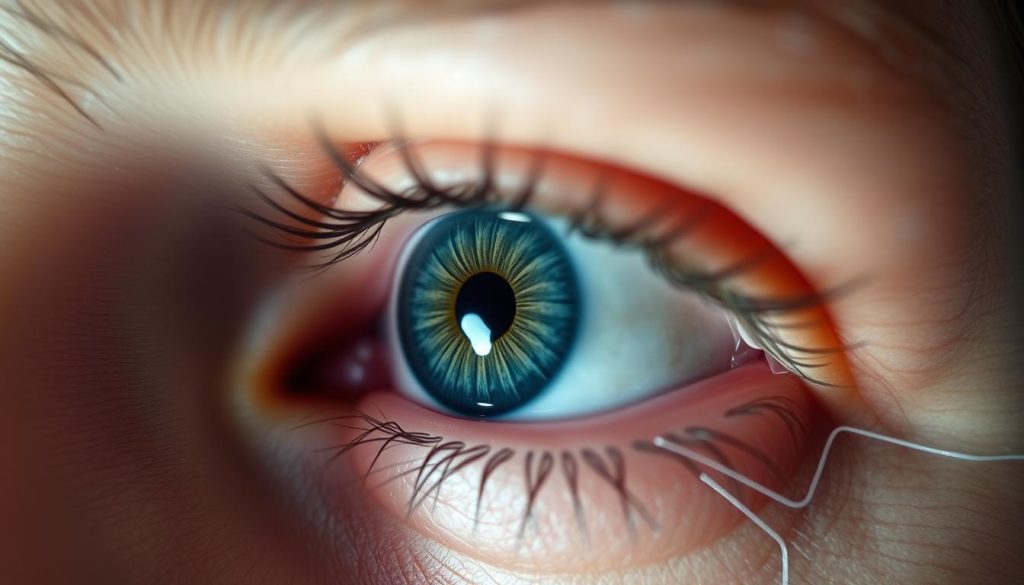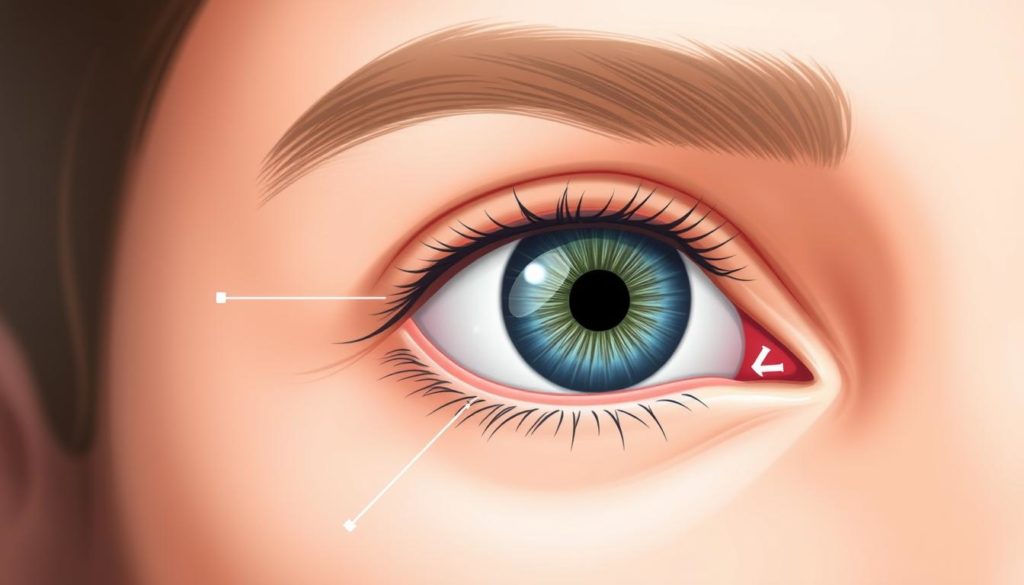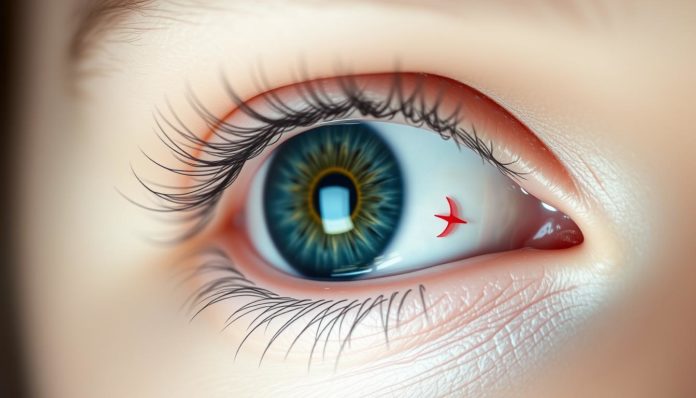“The greatest wealth is health.” – Virgil
Eye health is crucial, and Duane Syndrome is a unique condition that affects many. It’s a congenital issue that causes limited eye movement and misalignment. By looking into its causes and treatments, we can better manage it.
We’ll explore Duane Syndrome in detail, from symptoms to treatment options. Knowing more about this condition is key to improving life for those with it.
What is Duane Syndrome?
Duane Syndrome is a rare eye condition. It affects how eyes move horizontally. This can cause the eyes to misalign, known as strabismus. Knowing about Duane Syndrome is important for doctors and those with the condition.

Definition of Duane Syndrome
Duane Syndrome is a congenital eye disorder. People with it have trouble moving their eyes outward or inward. This leads to strabismus, making it hard to see depth and do everyday tasks.
Historical Background and Discovery
Alexander Duane, an eye doctor, first talked about Duane Syndrome in 1905. His findings helped us understand this eye disorder. Since then, more research has been done. It has helped us know there are different types of Duane Syndrome, each with its own signs and symptoms.
Common Symptoms of Duane Syndrome
Duane Syndrome shows several clear symptoms. Knowing these symptoms helps spot the issue early and get treatment fast.

Limited Eye Movement
People with Duane Syndrome often have limited eye movement. This is especially true when trying to look to the side. It’s a big sign of the condition.
Misalignment of the Eyes
Another key symptom is strabismus, or eyes that don’t line up right. This happens when the eyes don’t move together. It’s easy to see when the eyes point in different directions.
Other Associated Symptoms
Those with Duane Syndrome might also have other signs. These include turning their head to see better, narrowing their eyelids, and sometimes seeing things differently. Spotting these signs early is important for a quick diagnosis.
- Head turning
- Eyelid narrowing
- Vision disturbances
Causes of Duane Syndrome
Understanding Duane Syndrome’s causes is complex. Both genetic factors and environmental influences are at play. This condition affects eye health and is mostly present at birth. But, it can also appear later in life.
Genetic Factors
Research links genetic factors to Duane Syndrome. Studies found connections with genes like CHN1. This shows genetics play a big role in this congenital disorder.
Environmental Influences
Genetics are key, but pregnancy factors also matter. Maternal illnesses or toxins can harm the fetus’s eye health. This can lead to Duane Syndrome.
Congenital vs Acquired
Duane Syndrome is mostly present at birth. But, it can also appear later due to health issues. Understanding both forms helps in diagnosis and treatment.
Types of Duane Syndrome
Duane Syndrome is an eye movement disorder with three main types: Type I, Type II, and Type III. Knowing these types helps doctors diagnose and treat it better.
Type I
Type I is the most common. It makes it hard for the eye to move outward towards the ear. This can lead to eye misalignment and strabismus.
Type II
Type II affects the eye’s ability to move inward towards the nose. People with this type often tilt their head to see better. They also might have strabismus.
Type III
Type III is the most severe. It limits both outward and inward eye movements. This makes it hard for patients to move their eyes and can cause severe strabismus.
| Duane Syndrome Types | Characteristics | Common Symptoms |
|---|---|---|
| Type I | Limitation of abduction | Strabismus, difficulty moving eye outward |
| Type II | Limitation of adduction | Compensatory head postures, misalignment of the eyes |
| Type III | Limitation of both abduction and adduction | Severe strabismus, significant mobility challenges |
Diagnosis and Detection
The journey to a Duane Syndrome diagnosis starts with a detailed eye exam. This exam is key to spotting the syndrome’s signs and symptoms.
Ophthalmic Examination Procedures
Ophthalmologists use tests to check eye movements and positions. They look at how eyes move in different directions. This helps spot any issues with eye movement.
These tests give important clues about Duane Syndrome.
Role of Imaging Techniques
Imaging techniques like MRI are crucial for a Duane Syndrome diagnosis. They give detailed views of eye muscles and nearby areas. This helps rule out other causes of eye movement problems.
This thorough approach leads to accurate diagnosis and the right treatment plan.
Importance of Early Diagnosis
Spotting Duane Syndrome early is key for good management and treatment. Early diagnosis lets doctors start treatments to lessen symptoms. This improves the patient’s life quality.
Thanks to ophthalmology and imaging tech, diagnosing this condition early is easier. This leads to better results for patients.
Treatment Options for Duane Syndrome
There are many ways to treat Duane Syndrome to help people feel better and live better lives. One key method is vision therapy. It helps the brain get better at controlling eye movements.
- Eye patches or special glasses can help a bit by making eye muscles stronger.
- Prism lenses help the eyes work together better by correcting how they’re aligned.
- Eye movement therapy includes exercises to boost visual skills and comfort.
For more serious cases, orthoptic treatments might be needed. This is a special vision therapy that fixes eye misalignment with exercises and tasks. It aims to get the eyes and brain working together smoothly.
If other treatments don’t work, surgery might be suggested. It aims to fix eye muscle positions and improve movement.
The main goal of Duane Syndrome treatment is to make therapy fit each person’s needs. Whether it’s vision therapy, prisms, or surgery, the focus is on the patient’s health and happiness.
| Therapy Type | Application | Benefits |
|---|---|---|
| Vision Therapy | Exercises to improve coordination | Enhanced control over eye movements |
| Prism Lenses | Corrects misalignment | Better coordination and focus |
| Orthoptic Treatment | Exercises for muscle alignment | Improved visual comfort |
Surgical Treatments
Surgical treatments for Duane Syndrome aim to improve eye movement and fix any alignment problems. It’s important for both patients and doctors to understand the different surgeries. They need to know the possible risks and benefits.
Types of Surgical Procedures
There are several surgeries for Duane Syndrome. Two main ones are:
- Muscle Repositioning: This method adjusts the muscles that control eye movement. It helps improve how well the eyes work together.
- Transposition Surgeries: These surgeries move eye muscles to better align the eyes. They help with eye movement and fixing misalignment.
Risks and Benefits
Strabismus surgery and other treatments can greatly help patients. They can make eyes work better together and improve alignment. This can make life better for the patient.
But, there are risks too. These include infection, eyes being too straight or not straight enough. It’s important to think about these risks.
Non-Surgical Treatments
Non-surgical treatments are often the first choice for Duane Syndrome. They aim to improve eye health through vision therapy and other non-invasive methods. These strategies help enhance eye function and improve life quality for those with this condition.
Orthoptic Treatment
Orthoptic treatment includes exercises to strengthen eye muscles and improve coordination. Vision therapy sessions are customized for each person. They aim to fix misalignment and boost overall eye health.
Through regular practice, patients see big improvements in their vision.
Use of Optical Devices
Optical devices, like glasses with prisms, are another non-surgical option. These lenses help align the eyes and lessen symptoms like double vision. By using these devices daily, patients can better control their eye movements and keep their eyes healthy.
To compare the effectiveness of these non-surgical treatments, here is a detailed overview:
| Treatment Type | Method | Advantages | Desired Outcome |
|---|---|---|---|
| Orthoptic Treatment | Exercises to strengthen eye muscles | Non-invasive, tailored to individual needs, improves coordination | Enhanced eye muscle strength and coordination |
| Optical Devices | Glasses with prisms | Helps align eyes, reduces double vision | Better eye alignment and overall eye health |
Living with Duane Syndrome
Living with Duane Syndrome means facing daily challenges and finding ways to adapt. People often have limited peripheral vision and *eye alignment issues*. They need to use specific strategies for everyday tasks.
Daily Challenges and Adaptations
Those with Duane Syndrome find it hard with tasks needing a wide view. A common solution is using head positioning to improve vision. This helps them see better by aligning their head.
Support Systems and Resources
Having a strong support system is key for those *living with Duane Syndrome*. Doctors, like ophthalmologists and pediatric specialists, help manage the condition. They provide the right treatments.
Patient communities and groups, like the American Association for Pediatric Ophthalmology and Strabismus (AAPOS), offer great *patient support*. They provide resources, guidance, and share experiences. This helps individuals and their families deal with the condition’s challenges.
Current Research and Future Directions
Duane Syndrome research is making big strides. Scientists are learning more about its genetic roots. This could lead to new treatments that change how we care for patients.
Genetic Studies
Genetic studies on Duane Syndrome are uncovering important details. They aim to find the specific gene mutations linked to the disorder. This could help us understand its genetic makeup better.
Innovative Treatment Approaches
New treatments for Duane Syndrome are being developed. Researchers are working on new surgical methods and therapies. These could improve the lives of those with Duane Syndrome by better managing its symptoms.
Potential for Gene Therapy
Gene therapy for Duane Syndrome is a promising area. It could fix the genetic problems at their source. This could offer long-term, possibly permanent, ways to manage the condition.
| Research Area | Focus | Potential Benefits |
|---|---|---|
| Genetic Studies | Identifying gene mutations | Better understanding of hereditary factors |
| Innovative Treatments | New surgical techniques | Enhanced symptom management |
| Gene Therapy | Correcting genetic anomalies | Long-term solutions |
Conclusion and Key Takeaways
As we wrap up this detailed look, it’s important to highlight the main points about Duane syndrome. This rare eye disorder sheds light on how some people have trouble moving their eyes. Spotting symptoms early, like limited eye movement, is crucial for diagnosis and treatment.
Dealing with Duane syndrome needs a broad strategy. We must look at genetics, environment, and the different types of the disorder. There are many treatments, both surgery and non-surgery, to help improve eye health and life quality. Custom care plans, including surgery and non-invasive therapies, can really help.
Also, research is making new treatments possible, including gene therapy. This could make managing Duane syndrome even better in the future. Support groups and resources are also key in helping those with the condition face everyday challenges.
In short, being well-informed and proactive is essential. Whether you’re dealing with Duane syndrome yourself or supporting someone, knowing about the disorder and its treatments helps manage it better. This ensures a better life with Duane syndrome.
FAQ
What is Duane Syndrome?
Duane Syndrome is a rare eye disorder. It makes it hard to move the eye outward or inward. It’s a type of strabismus caused by nerve problems.
What are the common symptoms of Duane Syndrome?
Symptoms include limited eye movement and eyes that don’t line up right. People might turn their head to see better. They might also have vision problems sometimes.
What causes Duane Syndrome?
The exact cause is still unknown. But it’s often linked to genetics. Things in the womb might also play a part. Scientists are studying genes like CHN1 to learn more.
How is Duane Syndrome diagnosed?
Doctors use special tests to check eye movements. They might also use MRI scans. Early diagnosis helps manage the condition better.
What are the different types of Duane Syndrome?
There are three main types. Type I has limited outward movement. Type II has limited inward movement. Type III has problems with both.
What treatment options are available for Duane Syndrome?
Treatments include vision therapy and special glasses. Sometimes, surgery is needed. The goal is to improve how the eyes move, but there’s no cure.
What surgical treatments are there for Duane Syndrome?
Surgery can fix eye alignment. It involves moving muscles. But, it can also have risks like infection.
Are there non-surgical treatments for Duane Syndrome?
Yes, non-surgical treatments are often first. They include eye exercises and prism glasses. These help with vision and alignment.
How do people live with Duane Syndrome?
People adapt to challenges like vision problems. Support from doctors and others is key. It helps manage daily life.
What current research is being conducted on Duane Syndrome?
Research is ongoing. It includes genetic studies and new treatments. The goal is to improve care and outcomes for Duane Syndrome.


